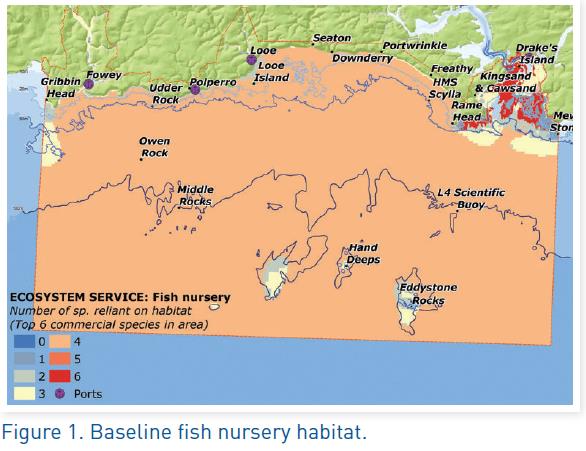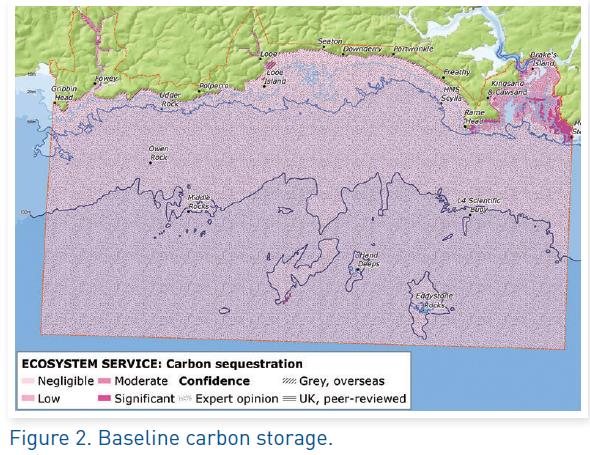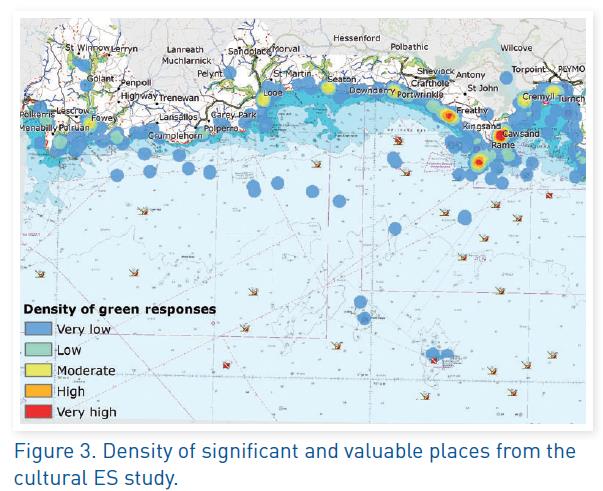The Place and the People we worked with
Spanning the Devon/Cornwall border, the busy Plymouth Sound gives way to rural open coast, beaches and cliffs and the small towns and estuaries of Looe and Fowey, which are typical of the south Cornwall coast. Offshore there are extensive rocky reefs and sandy expanses. Thriving tourism, recreation and fishing industries contribute to the rich maritime culture. Ports and harbours are interspersed with extensive protected landscapes and marine conservation designations.
There was no existing governance structure covering the whole case study, so the VALMER Plymouth Sound to Fowey case study team set up a Task and Finish stakeholder group of relevant marine and coastal managers and regulators for the project.
The Process
Through discussions with stakeholders it was agreed that a broadscale Ecosystem Service Assessment (ESA) would be undertaken, entailing valuation and mapping of all marine and coastal ecosystem services within the site, wherever possible. The project added considerable value through its Data Discovery exercise, processing, analysis and presentation/visualisation for a baseline assessment. Stakeholders also explicitly voiced a desire for cultural ecosystem services to be researched. This interest stemmed from the need to better understand the links between the marine environment and human well-being and the importance of tourism and recreation in the area. An additional discrete piece of research to quantify, map and visualise the health and wellbeing benefits associated with Plymouth Sound to Fowey area was undertaken by the University of Exeter.
The ESA process consisted of four connected steps:
- A baseline assessment of key ecosystem services in the case study area: nursery habitats (of key commercial species), coastal defence, waste processing, carbon storage, cultural services (particularly recreation and wellbeing)
- Stakeholder generated hypothetical future actions (resulting from the scenario building process undertaken during stakeholder meetings)
- Hypothetical actions developed into three scenarios
- Scenarios applied to the baseline with associated recalculation of the ESA for each of the three scenarios
The Three hypothetical scenarios developed for assessment were as follows:
- Recreational boating – exploring changes in Ecosystem Service (ES) delivery associated with changes in mooring type and a reduction in ecological footprint on the seabed.
- Marine Protected Areas (MPA) – exploring changes in ES delivery associated with the introduction of highly protected marine areas in the case study i.e. no extraction or deposition.
- Dredge disposal – exploring changes in ES delivery associated with closure of two dredge spoil disposal sites with combined materials taken to a re-opened site within the case study area further offshore.
The Results
In summary – The baseline maps of ecosystem service delivery illustrated the importance of Plymouth Sound, with its varied habitats, as a nursery for a range of commercial species (Figure 1).
The sand and coarse habitats that cover much of the case study site provided negligible levels of carbon storage relative to other habitats (Figure 2), although the value of the site for carbon storage nonetheless amounts to £1.4 million per year.
These habitats play a greater role in nutrient cycling and the provision of clean water. The value of the increased carbon storage alone through the recovery of seagrass following the replacement of swing moorings is unlikely to offset the costs of installing the new eco-buoys, although the values of other services that may also increase were not calculated. The dredge disposal scenario identified the potentially large increase in cultural services that could be obtained from relocation of the disposal site, while the MPA scenario highlighted the complex trade-offs that would require consideration in any management decision.
The cultural ecosystem services assessment showed that there was a deep connection between local people and the marine environment. Results highlighted a number of areas which managers could address to improve wellbeing and a series of hotspots on which coastal managers could focus their efforts (Figure 3).
Implications for Governance
The VALMER data, mapping and baseline ESA will be useful to most stakeholders as a decision support tool, for example in the delivery of the Cornwall Maritime Strategy by Cornwall Council. The Recreational Boating scenario would help Fowey Harbour Commissioners consider the implications of installing eco-buoys. The Dredge Disposal scenario was considered an interesting way to get people to look at an old problem in a new way: participation in the ESA process could be an effective mechanism to build local capacity on the topic. It was also a valuable tool for stakeholders to understand the complexities associated with building an ESA, and the range of formats ESA results can be presented in. Furthermore, stakeholders were able to use the scenarios and the ESA to explore trade-offs through changes in marine ecosystem service delivery.
For more information on the Plymouth Sound-Fowey case study please contact Philippa Hoskin: phhoskin@cornwall.gov.uk

 English
English  Français
Français 














Comments are currently closed for this case study!